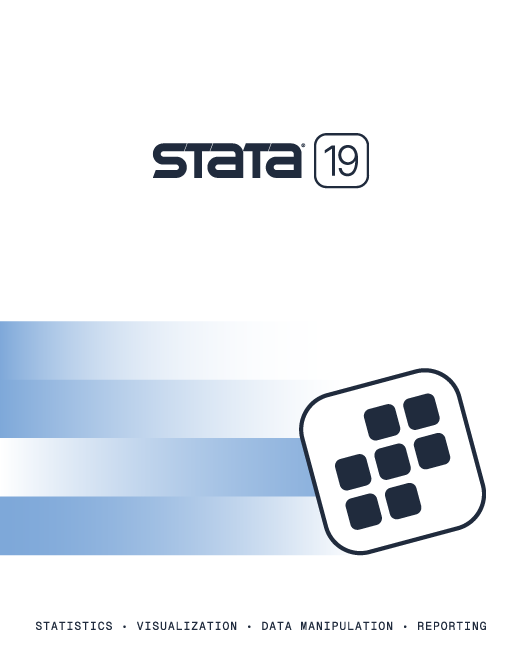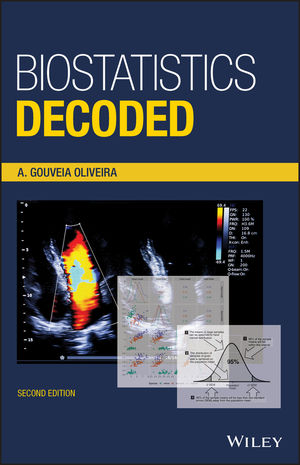

2025 Stata Conference • Nashville, TN • 31 July–01 August
Biostatistics Decoded, Second Edition |
||||||||||||||||||||||||||||||||
 Click to enlarge See the back cover |

As an Amazon Associate, StataCorp earns a small referral credit from
qualifying purchases made from affiliate links on our site.
eBook not available for this title
eBook not available for this title |
|
||||||||||||||||||||||||||||||
Comment from the Stata technical groupIn its second edition, Biostatistics Decoded expands and enhances the easy-to-underst and, math-light approach that characterized its first edition. Like its predecessor, it uniquely caters to readers of varying skill levels. Those new to the field can follow the plain text for conceptual understanding, while more advanced readers can delve into text boxes for detailed insights into statistical calculations. The scope of this edition goes beyond epidemiological and clinical research by incorporating chapters on experimental designs used in basic science research. It introduces new topics on study designs like quasi-experimental designs, pragmatic clinical trials, and cluster randomized trials, which serve to enrich the reader's comprehension of statistical methods. There's also an extensive discussion on methods based on the analysis of variance and an introduction to generalized linear models. The expanded sections on observational studies and the further developed chapter on meta-analysis are particularly insightful. The book's structure has been revamped to align more closely with different types of research, positioning the statistical methods used in each research type immediately after discussing the main research designs. This unique organization, differing from the traditional presentation of statistical methods, makes the book highly relevant for active researchers and professionals seeking to expand their statistical expertise. The examples are brought to life using Stata, making the book ideal for both introductory and advanced courses on biostatistics and research methodology as well as for experienced biostatisticians. |
||||||||||||||||||||||||||||||||
Table of contentsView table of contents >> Preface
1 Populations and Samples
1.1 The Object of Biostatistics
1.2 Scales of Measurement 1.3 Central Tendency Measures 1.4 Sampling 1.5 Inferences from Samples 1.6 Measures of Location and Dispersion 1.7 The Standard Deviation 1.8 The n − 1 Divisor 1.9 Degrees of Freedom 1.10 Variance of Binary Variables 1.11 Properties of Means and Variances 1.12 Descriptive Statistics 1.13 Sampling Variation 1.14 The Normal Distribution 1.15 The Central Limit Theorem 1.16 Properties of the Normal Distribution 1.17 Probability Distribution of Sample Means 1.18 The Standard Error of the Mean 1.19 The Value of the Standard Error 1.20 Distribution of Sample Proportions 1.21 Convergence of Binomial to Normal Distribution 2 Descriptive Studies
2.1 Designing a Research
2.2 Study Design 2.3 Classification of Descriptive Studies 2.4 Cross-sectional Studies 2.5 Inferences from Means 2.6 Confidence Intervals 2.7 Statistical Tables 2.8 The Case of Small Samples 2.9 Student’s t Distribution 2.10 Statistical Tables of the t Distribution 2.11 Inferences from Proportions 2.12 Statistical Tables of the Binomial Distribution 2.13 Sample Size Requirements 2.14 Longitudinal Studies 2.15 Incidence Studies 2.16 Cohort Studies 2.17 Inference from Incidence Studies 2.18 Standardization 2.19 Time-to-Event Cohort Studies 2.20 The Actuarial Method 2.21 The Kaplan–Meier Method 2.22 Probability Sampling 2.23 Simple Random Sampling 2.24 Replacement in Sampling 2.25 Stratified Sampling 2.26 Multistage Sampling 3 Analytical Studies
3.1 Objectives of Analytical Studies
3.2 Measures of Association 3.3 Odds, Logits, and Odds Ratios 3.4 Attributable Risk 3.5 Classification of Analytical Studies 3.6 Uncontrolled Analytical Studies 3.7 Comparative Analytical Studies 3.8 Hybrid Analytical Studies 3.9 Non-probability Sampling in Analytical Studies 3.10 Comparison of Two Means 3.11 Comparison of Two Means from Small Samples 3.12 Comparison of Two Proportions 4 Statistical Tests
4.1 The Null and Alternative Hypotheses
4.2 The z-Test 4.3 The p-Value 4.4 Student’s t-Test 4.5 The Binomial Test 4.6 The Chi-Square Test 4.7 The Table of the Chi-Square Distribution 4.8 Analysis of Variance 4.9 Partitioning the Sum of Squares 4.10 Statistical Tables of the F Distribution 4.11 The ANOVA Table 5 Aspects of Statistical Tests
5.1 One-Sided Tests
5.2 Power of a Statistical Test 5.3 Sample Size Estimation 5.4 Multiple Comparisons 5.5 Scale Transformation 5.6 Non-parametric Tests 6 Cross-sectional Studies
6.1 Linear Regression
6.2 The Least Squares Method 6.3 Linear Regression Estimates 6.4 Regression and Correlation 6.5 The F-Test in Linear Regression 6.6 Interpretation of Regression Analysis Results 6.7 Multiple Regression 6.8 Regression Diagnostics 6.9 Selection of Predictor Variables 6.10 Independent Nominal Variables 6.11 Interaction 6.12 Nonlinear Regression 7 Case-Control Studies
7.1 Analysis of Case–Control Studies
7.2 Logistic Regression 7.3 The Method of Maximum Likelihood 7.4 Estimation of the Logistic Regression Model 7.5 The Likelihood Ratio Test 7.6 Interpreting the Results of Logistic Regression 7.7 Regression Coefficients and Odds Ratios 7.8 Applications of Logistic Regression 7.9 The ROC Curve 7.10 Model Validation 8 Cohort Studies
8.1 Repeated Measurements
8.2 The Paired t-test 8.3 McNemar’s Test 8.4 Generalized Linear Models 8.5 The Logrank Test 8.6 The Adjusted Logrank Test 8.7 The Incidence Rate Ratio 8.8 The Cox Proportional Hazards Model 8.9 Assumptions of the Cox Model 8.10 Interpretation of Cox Regression 9 Measurement
9.1 Construction of Clinical Questionnaires
9.2 Factor Analysis 9.3 Interpretation of Factor Analysis 9.4 Factor Rotation 9.5 Factor Scores 9.6 Reliability 9.7 Concordance 9.8 Validity 9.9 Validation of Diagnostic Tests 10 Experimental Studies
10.1 Main Design Features and Classification
10.2 Experimental Controls 10.3 Replicates 10.4 Classification of Experimental Designs 10.5 Completely Randomized Design 10.6 Interaction 10.7 Full Factorial Design 10.8 The Random Effects Model 10.9 Components of Variance 10.10 ANOVA Model II and Model III 10.11 Rules for the Definition of the Error Terms 10.12 ANOVA on Ranks 11 Blocking
11.1 Randomized Block Design
11.2 Generalized Randomized Block Design 11.3 Incomplete Block Design 11.4 Factorial Design with Randomized Blocks 11.5 Latin and Greco-Latin Square Design 12 Simultaneous Inference
12.1 Multiple Comparisons
12.2 Generalist Methods 12.3 Multiple Comparisons of Group Means 12.4 Pairwise Comparison of Means 12.5 Different Variances 12.6 Comparison to a Control 12.7 Comparison of post hoc Tests 12.8 Complex Comparisons 12.9 Tests of Multiple Contrasts 12.10 A posteriori Contrasts 12.11 The Size of an Experiment 13 Factorial ANOVA
13.1 The n-Way ANOVA
13.2 The 2k Factorial Design 13.3 The 2k Factorial Design with Blocking 13.4 The Fractional Factorial Design 14 Nested Designs
14.1 Split–Plot Design
14.2 Nested (Hierarchical) Design 14.3 Mixed Model Nested ANOVA 14.4 Mixed Model Nested ANOVA with Three Sublevels 14.5 Pure Model II Nested ANOVA 15 Repeated Designs
15.1 Repeated Measures ANOVA
15.2 Repeated Measures ANOVA with Two Factors 15.3 ANOVA with Several Repeated Measures 15.4 Multivariate Tests 16 Clinical Trials
16.1 Classification of Clinical Trials
16.2 The Clinical Trial Population 16.3 The Efficacy Criteria 16.4 Controlled Clinical Trials 16.5 The Control Group 16.6 Blinding 16.7 Randomization 16.8 Non-comparative Clinical Trials 16.9 Regression Toward the Mean 16.10 Non-randomized Controlled Clinical Trials 16.11 Classical Randomized Clinical Trial Designs 16.12 Alternative Clinical Trial Designs 16.13 Pragmatic Clinical Trials 16.14 Cluster Randomized Trials 16.15 The Size of a Clinical Trial 16.16 Non-inferiority Clinical Trials 16.17 Adaptive Clinical Trials 16.18 Group Sequential Plans 16.19 The Alpha Spending Function 16.20 The Clinical Trial Protocol 16.21 The Data Record 17 Analysis of Clinical Trials
17.1 General Analysis Plan
17.2 Data Preparation 17.3 Study Populations 17.4 Primary Efficacy Analysis 17.5 Analysis of Multiple Endpoints 17.6 Secondary Analyses 17.7 Safety Analysis 18 Meta-analysis
18.1 Purpose of Meta-analysis
18.2 Measures of Effect 18.3 The Inverse Variance Method 18.4 The Random Effects Model 18.5 Heterogeneity 18.6 Publication Bias 18.7 The Forest Plot References
Index
|
||||||||||||||||||||||||||||||||
Learn
Free webinars
NetCourses
Classroom and web training
Organizational training
Video tutorials
Third-party courses
Web resources
Teaching with Stata
© Copyright 1996–2025 StataCorp LLC. All rights reserved.
×
We use cookies to ensure that we give you the best experience on our website—to enhance site navigation, to analyze usage, and to assist in our marketing efforts. By continuing to use our site, you consent to the storing of cookies on your device and agree to delivery of content, including web fonts and JavaScript, from third party web services.
Cookie Settings
Last updated: 16 November 2022
StataCorp LLC (StataCorp) strives to provide our users with exceptional products and services. To do so, we must collect personal information from you. This information is necessary to conduct business with our existing and potential customers. We collect and use this information only where we may legally do so. This policy explains what personal information we collect, how we use it, and what rights you have to that information.
These cookies are essential for our website to function and do not store any personally identifiable information. These cookies cannot be disabled.
This website uses cookies to provide you with a better user experience. A cookie is a small piece of data our website stores on a site visitor's hard drive and accesses each time you visit so we can improve your access to our site, better understand how you use our site, and serve you content that may be of interest to you. For instance, we store a cookie when you log in to our shopping cart so that we can maintain your shopping cart should you not complete checkout. These cookies do not directly store your personal information, but they do support the ability to uniquely identify your internet browser and device.
Please note: Clearing your browser cookies at any time will undo preferences saved here. The option selected here will apply only to the device you are currently using.